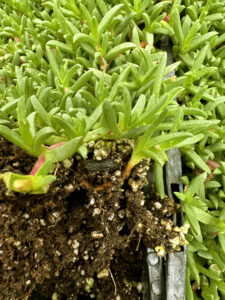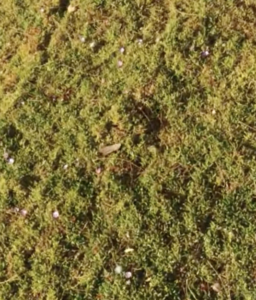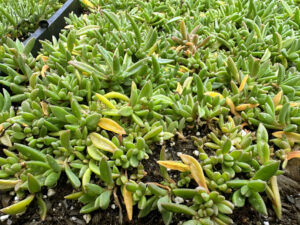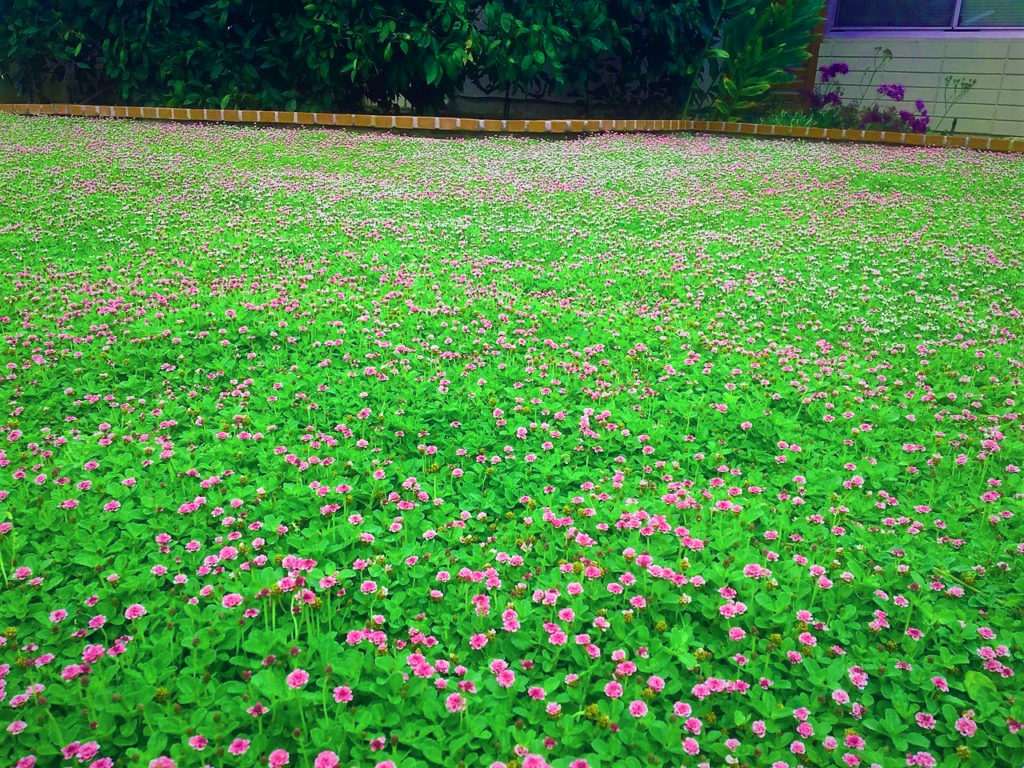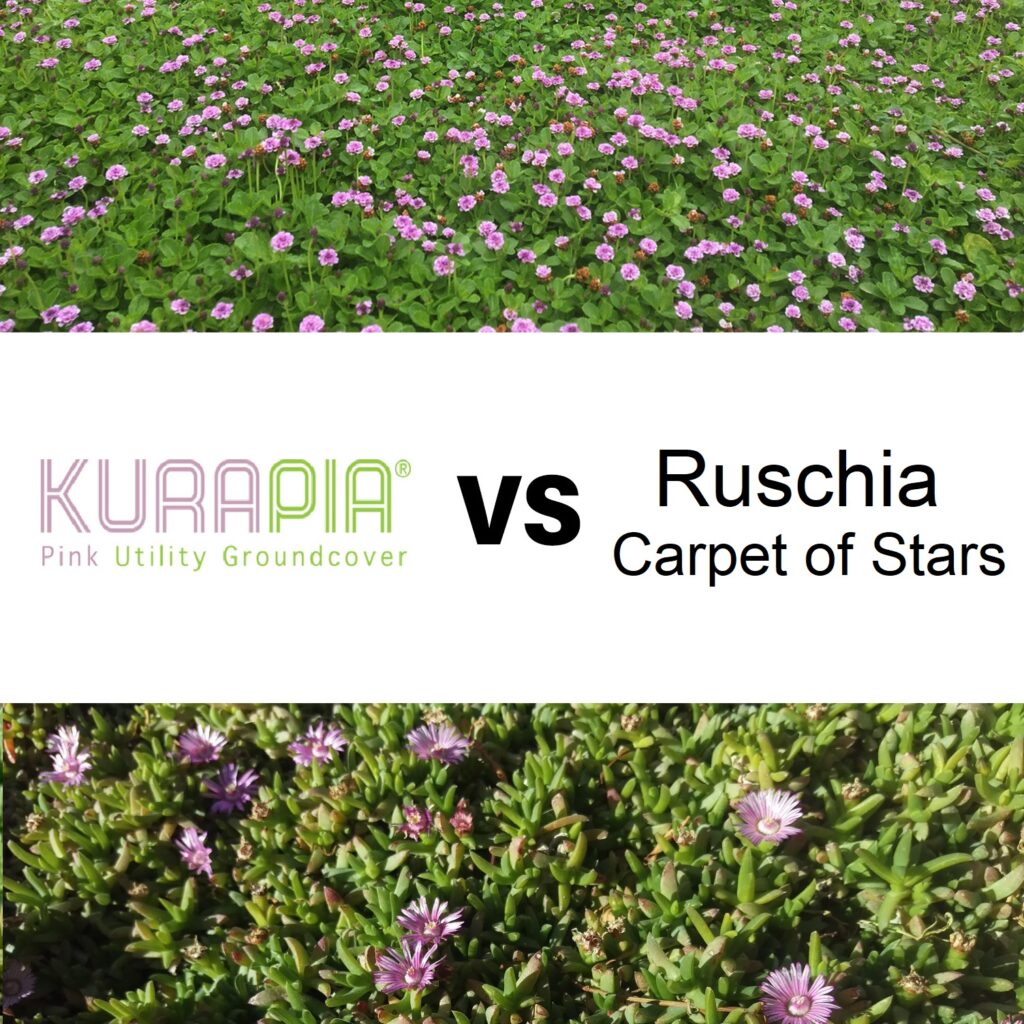
Kurapia vs Ruschia Carpet of Stars
Kurapia New White and Kurapia Pink remain the undisputed champs in the world of drought tolerant groundcover and turf. However we are occasionally asked how we compare to Ruschia lineolata (Carpet of Stars), a variety of iceplant and low growing ground cover with linear succulent leaves.
Ruschia ‘Nana’ (Carpet of Stars). Ruschia is one of the new groundcovers that customers have seen on the end caps of many popular box stores in the past few years. Sold in groundcover flats and small plugs, Carpet of Stars has some interesting claims, so lets get the skinny.
How Does Kurapia Pink Compare to Ruschia (Carpet of Stars)?
1. Foot Traffic
Ruschia grows low and flat, forming little mats that start to blend into each other. These plants are single plants that start to become woody and sparse as it ages. The leaves are upright, pointy succulent leaves that do take damage from foot traffic. The more it’s walked on, the more the leaves get crushed and struggle to repair itself. Our Kurapia plugs fill in dramatically, as the stems spread across the soil it forms new plants, which keeps the plant lush and self-repairing. Unlike Ruschia, Kurapia is always replenishing itself with new plants on short runners. Advantage: Kurapia Pink
2. Hardiness & Longevity
While Kurapia continues to regenerate growth over time, Ruschia needs to be replaced every few years. As Ruschia ages, its stems become thicker and produce less and less leaves, leaving an unattractive skeletal looking plant. This will soon begin to rot over time and become a nest for pests. Most landscapers that promote Ruschia Carpet of Stars will tell you to expect to replace it every 3-4 years. Kurapia keeps growing and looking great. Advantage: Kurapia Pink
3. Erosion Control
The reason that Kurapia is such a great way to prevent erosion is because you need plants with deep roots that cover as much of the soil as possible. Kurapia roots grow deeper than 6 feet, which anchor the soil well. Ruschia, like most succulents, store water in its leaves almost exclusively, meaning it doesn’t produce deep roots. The fact that it’s essentially masses of flat plants, it won’t hold back soil very well, as most of the plant lays on the topsoil. Kurapia also forms a dense mat of plants & roots, while Ruschia does not. Kurapia is far superior for erosion control. Advantage: Kurapia Pink

the roots of Ruschia “Carpet of Stars” aren’t very deep compared to Kurapia Pink or Kurapia New White, and it lays in clumps across the soil
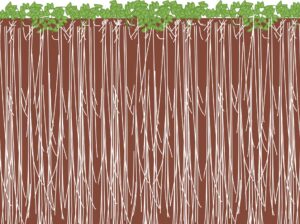
Kurapia Pink and Kurapia New White both grow deep roots, up to 9′ or longer, making it perfect for anchoring to hillsides and being drought tolerant
4. Affordability
Most installations have installers bringing in huge stacks of square groundcover flats, laying the product down end over end, so expensive! The growers of Carpet of Stars recommend planting it every six inches if you’re using plugs. We recommend planting Kurapia from 12” to 15”. If you plant every 15 inches, a 100 square foot area takes 64-68 plants. Planting every 12 inches, a 100 square foot plot takes 100-105 plants. If you’re planting ever 6”, you need 400-449 plants to cover 100 square foot.
Spacing 15 inches 12 inches 6 inches
Plants needed 64-68 plants 100-105 plants 400-449 plants
You’re paying quite a bit more for the coverage for Carpet of Stars, and you’ll end up having to replace in a few years. Not a good idea. The amount of labor alone is much higher! Advantage: Kurapia Pink
5. Weed Control
Since Ruschia lays flat across the soil, it’s very easy for annual weeds and grasses to pop up through the leaves, especially as the Ruschia ages. Kurapia forms a thick, dense mat of plants all tightly pressed together, making it harder for weeds to get through and germinate. Advantage: Kurapia Pink
6. Walkability
Ruschia grows upright on succulent stems that ends a bit of a point. While some people enjoy this, most prefer the feeling of Kurapia Pink and White’s horizontal growth patterns. It’s really a matter of the comfort of leaves that lay on top of each other on small flat leaves, or pointing up like small spears. Your bare feet will tell you quickly which one it prefers, as will your dogs and children. Advantage: Kurapia Pink
7. Speed of Growth
Ruschia Carpet of Stars is most commonly installed in groundcover flats directly on the soil (so expensive) or the plugs are planted every six inches. This tells you all you need to know. Ruschia grows much slower than Kurapia. In warm weather, spaced from 12″ to 15″, Kurapia New White and Pink plugs can completely fill your turf in less that two months. Ruschia can’t make this claim. Advantage: Kurapia Pink
Winner: Kurapia Pink!
Ruschia Carpet of Stars is something many people are curious about. It’s always important to read the fine print vs the slick marketing. We at Kurapia.com absolutely want to be sure you have the best plants in your yard, and love to support our hundreds of satisfied customers.
Come shop with us or run our handy-dandy calculator and see how many kurapia plants we recommend for your yard?
Thank you for visiting Kurapia.com, the ultimate drought tolerant groundcover and lawn alternative.


